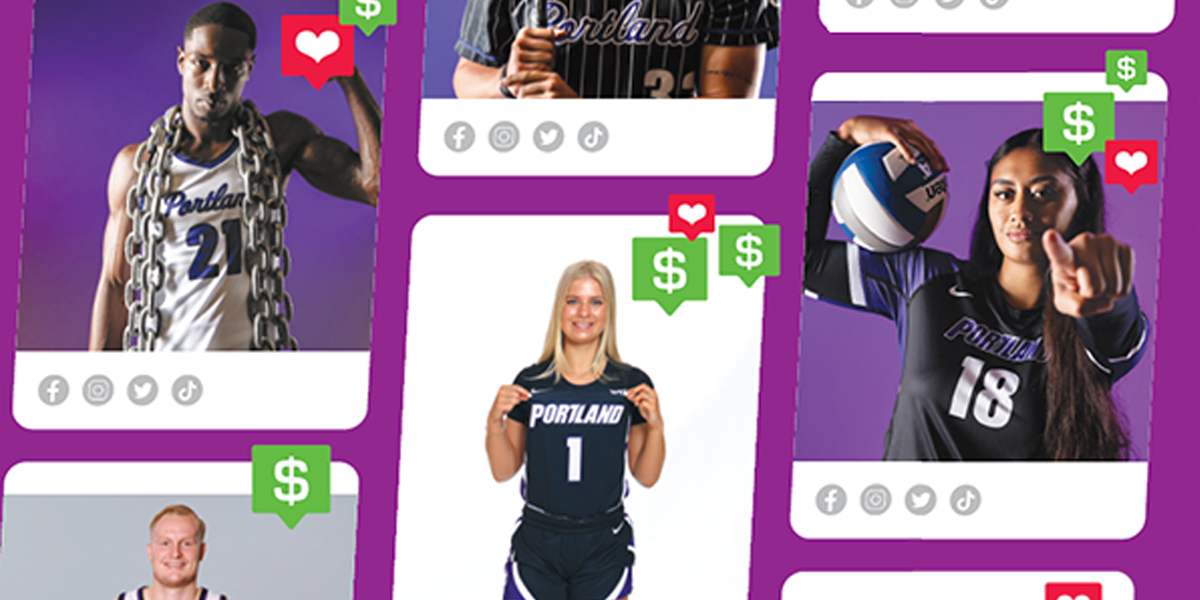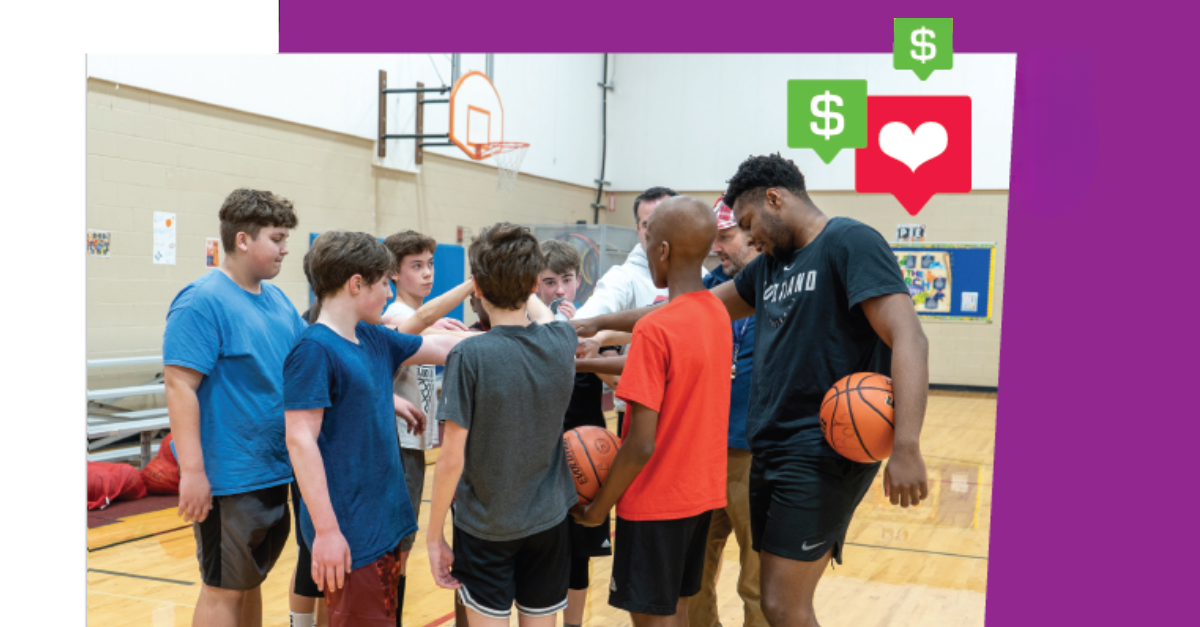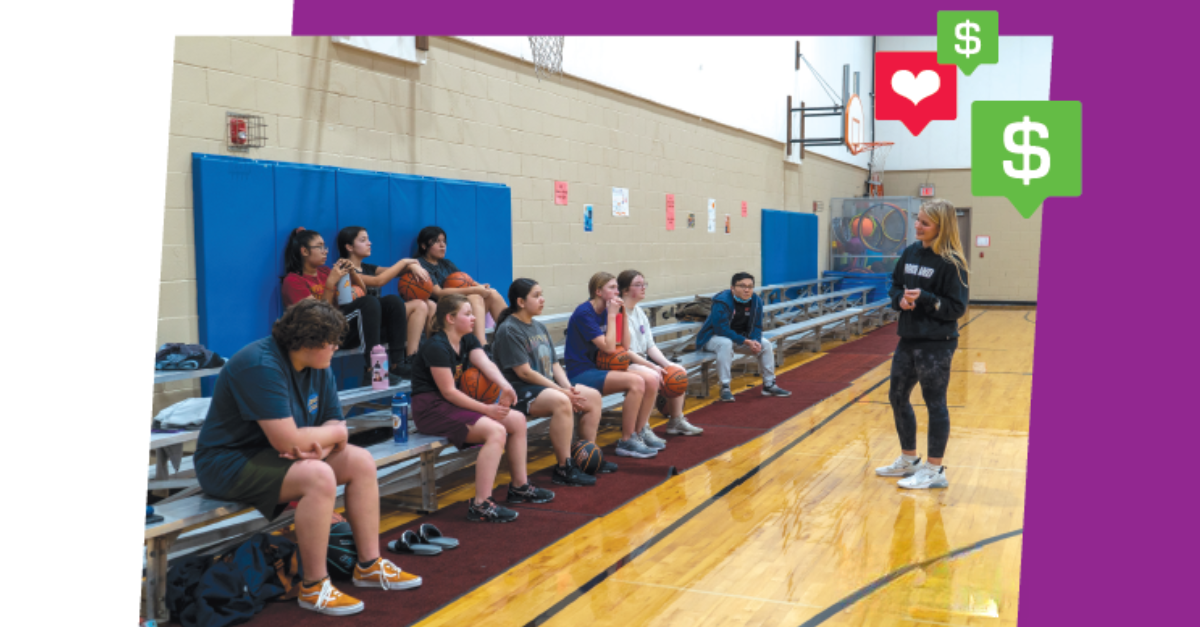Portland Magazine
February 20, 2024
University of Portland athletics enters into the landscape of Name, Image, and Likeness (NIL) deals with a focus on what’s best for the student athlete.
Story by Cheston Knapp

LAST SPRING, CHIKA Nduka and McKelle Meek ’24, from UP’s Men’s and Women’s basketball teams, visited a local parish school in North Portland, where they put on a clinic for the middle schoolers. They impressed the students with their skills and inspired them with accounts of their journeys to becoming Division One athletes. And this past summer, while back in Australia, Tyler Robertson ’23 talked to four hundred kids from his hometown about the challenges he’s faced on and off the court. In true Local Boy Makes Good fashion, he then led a camp for members of the club he grew up playing for.
Stories of UP students serving the community in heartening ways aren’t surprising—they’re perhaps most remarkable for how common they are. But what makes these two events different is that the student athletes were being paid for their outreach.
Until recently, events like these, where student athletes openly profit off their name, image, and likeness (or NIL), were first order no-nos. Strictly verboten. Money, so the argument went, eroded the very foundation of college sports: amateurism. And if you violated these rules, you were greeted with punishment both swift and severe. Suspensions, fines, awards rescinded, seasons annulled—all glory ground to dust. Athletes who crossed the line had their reputations forever tarnished. Elgin Baylor, Eric Dickerson, Chris Webber, Reggie Bush, Johnny Manziel, and so on down the list. A list, it goes without saying, that can only include those players and coaches who were caught. Prevailing wisdom holds that cases like these were just the tip of the iceberg, that there has always been money in college sports. Just because you couldn’t see it didn’t mean it wasn’t there.
But in the summer of 2021, the Supreme Court handed down a rare unanimous decision that loosened the NCAA’s iron grip on the financial lives of student athletes. NCAA v. Alston addressed a seemingly anodyne issue having to do with education-related expenses. Schools could now provide support for laptops or textbooks or other school supplies—any of the many incidental expenses not covered by a scholarship—and not fall afoul of the NCAA. The case had sweeping ramifications, ones that have forever changed the landscape of college sports. While it was narrow in its legal scope, the Supreme Court used the case as an opportunity to undercut every argument the NCAA had used to define itself. It’s no secret that businesses everywhere struggle with the problem of labor and for more than forty years, the NCAA had been balancing on a stool with one leg, claiming that its product, college sports writ large, was defined by not paying its workers (student athletes) a fair market value. “The NCAA’s business model would be flatly illegal in almost any other industry in America,” one Justice wrote, flatly. Seeing the writing on the wall, the NCAA then voted to allow students to retain the rights to their name, image, and likeness.
“It was a good and necessary change,” said Scott Leykam, UP’s Vice President and Director of Athletics. “It wasn’t congruent that a regular student could make money from a musical performance or by partnering with a local business and a student athlete couldn’t.”
The rollout of NIL has been rocky, in part because there are no uniform federal guidelines. Rules and regulations were left up to individual states to set, and some have passed far more lenient ones than others, which has led to fears of an unlevel playing field. Given this volatility, it’s worth noting what it is not. NIL is not pay-to-play. Universities are not offering athletes money, outside of scholarships, to come play for them. NIL refers to student athletes being able to capitalize on the recognition they’ve won on the field or court. Or off it, for those who have built large social media followings. They can sell autographs, appear in an ad for a local sandwich shop or car dealership, endorse a deodorant on Instagram, and accept a little something for their trouble. They can turn themselves into a “brand.” But every NIL deal, at bottom, must involve a quid pro quo. The student athlete has to do something other than play their sport to receive their payment from a business or third-party group. And judging by the numbers—last year, athletes made more than a billion dollars in NIL deals—it’s safe to assume there’s no going back.
“It’s a new reality and we have to keep up, whether you like it or not,” said Shantay Legans, the coach of UP’s Men’s Basketball team. “You just don’t want to be left behind.”

Being left behind has become a common fear for athletics departments all over the country. The NCAA made this change hastily, without guardrails or governance in place. It’s been so lawless and chaotic that most reports call it a Wild West situation. Players are being enticed to attend a certain school because of the promise of exorbitant NIL deals. They’re being lured into the transfer portal because of them. And this has upended the way business has always been done at the collegiate level.
The majority of these NIL deals—north of eighty percent, according to one estimate—are funded and brokered by what are called “collectives.” You can think of collectives as the Political Action Committees of college sports. They’re third-party organizations, unaffiliated with institutions, that have been incorporated to create and funnel NIL opportunities to a school’s student athletes. These are typically run by boosters, alums, and other supporters. At large schools in the Power Five conferences, as well as at some mid-majors, collectives have been able to raise staggering amounts of money, and often offer huge deals to star players for paper-thin quid pro quos. Think: $50,000 for a ten-minute appearance on a booster’s podcast. Or: receiving a $100,000 car for a few autographs. At their worst, these collectives have replaced the back-alley middlemen who used to slip players envelopes of cash and buy them watches and send them on all-expenses-paid vacations.
“It’s been a race to the bottom,” said Jason Brough, UP’s Senior Associate Athletic Director. What he means is that it’s easier for collectives to operate in those states with lenient laws. One in Texas, for example, can generate more lucrative deals than one in Georgia or Alabama, which has led to fears over recruiting and retention, and to accusations that teams are buying players off. This is happening in every conference—UP has seen a couple Men’s Basketball players transfer, in part because of NIL offers.
How can UP’s Athletics Department stay competitive and not lose its players, players it has invested time and, yes, money, into developing, without stooping to the lowest level? Is there an ethical way to engage in NIL? Joe Kuffner ’05 thinks so. Kuffner is a longtime UP superfan and bubbles with an infectious Pilot Pride. More than a year ago now, he launched Back the Bluff, UP’s collective, with an eye to upholding the school’s commitment to service and integrity.

“We want to embrace the rules and engage with them in a way that the UP community can feel good about,” Kuffner said.
The most egregious NIL stories involve tampering with players, either prospective or current, and trying to lure them away from places that recruited them through more traditional avenues. Back the Bluff has defined itself against that practice, unsurprisingly.
“We see this as a retention tool,” Kuffner said. “Not a recruiting one.”
One of Kuffner’s responsibilities as head of the collective is developing relationships with nonprofits in Portland to facilitate possible NIL deals down the line. He orchestrated the event at the parish school for Meek and Nduka, as well as the one in Australia for Robertson.
“I don’t want them doing nothing,” Coach Legans said. “I want them to give back, to be out in the community and making a difference. This is a special place and I want guys here who feel that, who want to be here.”
These events have the added benefit of strengthening the school’s connection to the city.
“I’d love to see it become a real vital part of this community,” Kuffner said. “We could help develop the fanbase through partnerships with local sports and youth organizations and keep shrinking the distance between campus and the neighborhood.”
Collectives are the top-down approach to NIL deals. The bottom-up one, which is closer to the spirit of the initial idea, turns the individual student athlete into an entrepreneur. The most famous college athletes, especially those who have built enormous social media followings, can capitalize on that fame. But there are extensive resources available for athletes who don’t boast big numbers on Instagram or TikTok. In the fall, UP’s Athletics Department partnered with Opendorse, a digital marketplace where student athletes can build their brand and search for NIL opportunities.
“We’re doing everything we can to support our students,” Leykam said. “That’s our North Star.”
Opendorse looks much like any social media platform. Student athletes build out profiles by posting pictures of themselves, both on and off the field of play, and writing short bios about themselves. Companies can then tailor and refine their search, browsing by sport and students’ interests. They might be in the market for a first-generation rower or a beach volleyball player who cares about animal rights or a basketball player who loves pickles. A representative from the company, Hannah Beatus, came to campus to walk students through the process. During her presentation, she encouraged them to be detailed and specific about what they like to do when they’re not playing their sport.
“Core values and stuff they like to do off the field are big,” Beatus said.
Student athletes can be proactive, too, by applying to opportunities posted on the site. In the fall, soon after UP’s site launched, Violet Rademacher ’26, a member of the Women’s Soccer team, landed a deal with Epic Hire, a networking site that helps current college students find jobs. Employers can only learn so much from a resume, so they use storytelling to give a more complete picture of the student’s experience.
“I had to download the app, make a profile, and post three stories,” Rademacher said. “I can make more by referring five other student athletes, too.”
Opendorse handles all the compliance, ensuring that all the deals involve a quid pro quo and conform to the state’s rules. They act, more or less, as an agency, and are working on creative ways to prepare student athletes for their futures, like offering an opportunity for them to earn their real estate license through the site.
And students are, of course, welcome to pursue opportunities off the site. For example, a couple members of the Men’s Soccer team have launched a coaching business. “The type of training we provide is pretty technical,” Michael Hatcher ’24 said. “So the younger they can start, the better.”
Michael and his teammates see the business as a way to give back to the soccer community in Portland, as well as to the school and the team. They hope that the business will continue on after they’ve graduated, that future Pilots will have the access to this side hustle. And he’s been pleasantly surprised by how many clients they’ve been able to pick up, mostly through word-of-mouth and through social media posts. They’re getting real-world experience in all the aspects of running a small business, experience they wouldn’t have gotten without the changes to NIL.
For those of us who were reared on the old mottoes, who swallowed the idea of amateurism hook, line, and sinker, all these changes can be hard to comprehend. And, at times, stomach. But the Pilots will continue navigating this tumultuous new reality with a firm hand on the rudder and their sights ever set on their North Star.
CHESTON KNAPP is Portland magazine’s senior writer and associate editor.
University of Portland
5000 N. Willamette Blvd.,
Portland, Oregon 97203-5798
503.943.8000
This website uses cookies to track information for analytics purposes. You can view the full University of Portland privacy policy for more information.
